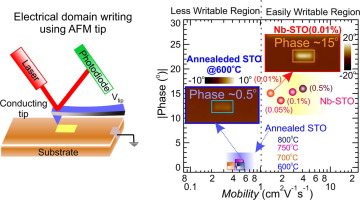当前位置:
X-MOL 学术
›
Appl. Surf. Sci.
›
论文详情
Our official English website, www.x-mol.net, welcomes your
feedback! (Note: you will need to create a separate account there.)
Nano-electrical domain writing for oxide electronics
Applied Surface Science ( IF 6.3 ) Pub Date : 2020-04-01 , DOI: 10.1016/j.apsusc.2019.145214 Neha Wadehra , Nand Kumar , Shivam Mishra , Ruchi Tomar , S. Chakraverty
Applied Surface Science ( IF 6.3 ) Pub Date : 2020-04-01 , DOI: 10.1016/j.apsusc.2019.145214 Neha Wadehra , Nand Kumar , Shivam Mishra , Ruchi Tomar , S. Chakraverty

|
Abstract In this paper, we report writing of localized nano-electrical domains using atomic force microscopy tip on the surface of different kinds of (bulk, surface and interface) conducting oxide material namely, SrTiO3. The origin of conductivity in these samples has different mechanisms. Our experimental observations present a unified picture of charge writing process and clarifies the dynamics of accumulation/depletion of charge in the samples. We have found that free mobile carriers are a pre-requisite for writing electrical domains. Charge writing capability as well as diffusion of charge from the written region are found to show strong dependence on the mobility of the carriers. Through a control experiment, we have demonstrated that by introducing defects (oxygen vacancies), stability of the written pattern can be increased. Our results provide a guidance to achieve higher performance in oxide based nano-electrical memory devices.
中文翻译:

氧化物电子的纳米电子域写入
摘要 在本文中,我们报道了使用原子力显微镜尖端在不同种类(本体、表面和界面)导电氧化物材料,即 SrTiO3 的表面上写入局部纳米电畴。这些样品中导电性的起源有不同的机制。我们的实验观察呈现了电荷写入过程的统一图景,并阐明了样品中电荷积累/消耗的动态。我们发现免费的移动运营商是编写电气域的先决条件。发现电荷写入能力以及来自写入区域的电荷扩散显示出对载流子迁移率的强烈依赖性。通过控制实验,我们已经证明通过引入缺陷(氧空位),可以增加写入图案的稳定性。
更新日期:2020-04-01
中文翻译:

氧化物电子的纳米电子域写入
摘要 在本文中,我们报道了使用原子力显微镜尖端在不同种类(本体、表面和界面)导电氧化物材料,即 SrTiO3 的表面上写入局部纳米电畴。这些样品中导电性的起源有不同的机制。我们的实验观察呈现了电荷写入过程的统一图景,并阐明了样品中电荷积累/消耗的动态。我们发现免费的移动运营商是编写电气域的先决条件。发现电荷写入能力以及来自写入区域的电荷扩散显示出对载流子迁移率的强烈依赖性。通过控制实验,我们已经证明通过引入缺陷(氧空位),可以增加写入图案的稳定性。











































 京公网安备 11010802027423号
京公网安备 11010802027423号